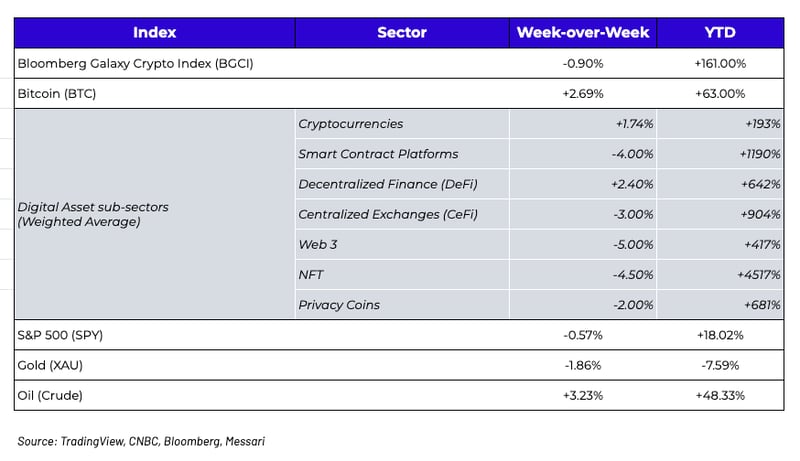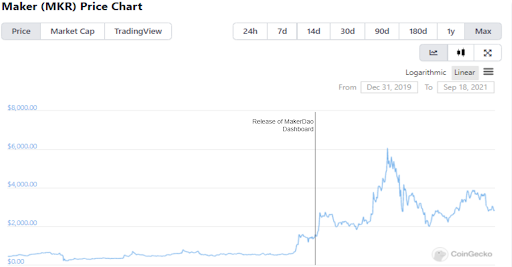 What happened this week in the Digital Assets market
What happened this week in the Digital Assets market
Week-over-Week Price Changes (as of Sunday, 9/19/21)
Activist Investors Would be Beneficial to Digital Assets
Over a year ago, Arca was involved in the first activist campaign in digital assets. Our goal at the time was simple -- to shed light on the lack of transparency and questionable activities by a digital token issuer, and to fight for token holder rights and value creation. More broadly, we’ve been advocates for increased transparency for years, in an effort to bring the best practices from traditional finance to the new and exciting world of digital assets. In recent weeks, there have been numerous activities in digital assets that bring this effort back into focus. Much like Muddy Waters, Citron Research, and individual anonymous researchers bring a checks and balances system to traditional financial markets, we strongly believe that deep research and public constructivism can help to improve the digital assets industry.
Digital assets participants talk a lot about the industry’s ability to regulate itself. There is a lot of truth to this, as the transparent nature of blockchains allow any user to spend a couple of hours on block explorers (like Etherscan) to track any and all transactions from any given wallet. Companies like Dune Analytics allow for anyone to tap into this data and spin up a dashboard on the usage and financial well-being of any project or company built on blockchain rails. As analysts, we can check these dashboards every day and make better decisions on projects in real-time rather than waiting for delayed quarterly reports from traditional public and private companies. That said, as an industry that thinks it can regulate itself and prides itself on transparency, it is time to set some industry standards. Companies and projects need to recognize the importance of setting up transparency dashboards, and analysts across the industry need to roll up their sleeves and do the dirty work of bringing transparency to projects that are not doing it themselves.
The Bad - Lack of Transparency
Last week, an anonymous researcher by the name of ZuwuTV called out OpenSea’s Head of Product, Nate Chastain, for front-running OpenSea’s users. As Head of Product, Chastain chose what NFT projects are featured on OpenSea’s front page. Projects featured on the front page often see significant price appreciation due to the exposure. Chastain was buying these NFTs before pushing them to the front page and flipping them for profits; a clear abuse of power and profiting off OpenSea’s users.
ZuwuTV was able to track these movements because Chastain used his crypto punk, the highly coveted NFT collection that often comes with a price tag in the millions, as his Twitter profile picture. By finding the same punk on OpenSea, ZuwuTV was able to find Chastain’s Ethereum address. From there, ZuwuTV used Etherscan to see Chastain’s other “secret wallets” that his “punk wallet” was sent ETH to. He tracked the buying of other NFT collections that within hours were featured on OpenSea’s front page. And Tracked the sales after the prices ran up, and the profits that flowed back into Chastain’s “punk wallet”.
Because ZuwuTV published his findings on Twitter, OpenSea ultimately terminated Chastain as head of product and released policies prohibiting employees from trading using confidential information. But not before they received serious reputational damage. The fact that these policies were not already in place at a company valued as a Unicorn and funded with well over $100mm proves that the digital assets industry still has a long way to go in establishing best practices. We hope that OpenSea becomes both a better company and a better steward of transparency because of this, and we applaud the actions of ZuwuTV in helping to self-police our industry.
The Ugly - ICP
The Internet Computer, formally known as Dfinity, is a Layer 1 blockchain designed to reduce bandwidth constraints and allow for all Web 3.0 applications to be built on top of it. In February 2018, Dfinity raised $61mm and then another $102mm in August 2018, bringing total funding to $166.9mm.
Earlier this year, The Internet Computer finally released its token, which, on a fully diluted basis, was the third-ranked digital asset by market cap behind just BTC and ETH. With no usage, no transparency, and an insane $200 bn+ valuation, ICP proceeded to fall 94% from mid-May to the end of June, crushing investors and triggering well reasoned criticism.
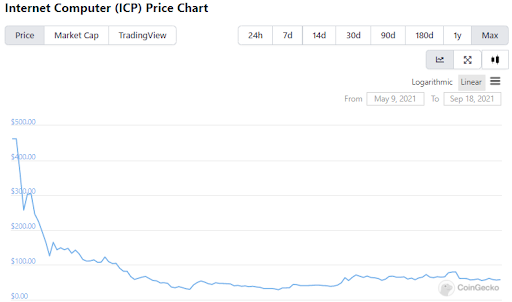
Source: Coingecko
After a report by Arkham intelligence came out, which claimed that not every ICP holder was getting equally hurt by the price decline, it was revealed that some of those who were potentially doing the crushing, including Dfinity’s own treasury wallet. Arkham intelligence found that “Addresses we suspect belong to the Dfinity treasury and project insiders have deposited 18.9 million ICP, worth ~$3.6 billion at time of deposit, to exchanges.”
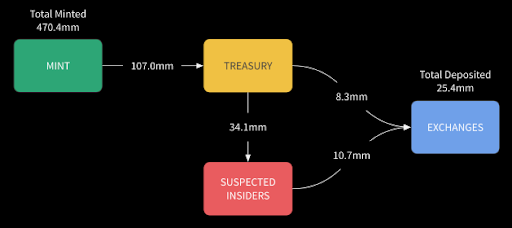
Furthermore, in response to a Twitter question, Dominic Williams, CEO of the Dfinity foundation indicated that there was no vesting schedule for treasury tokens.
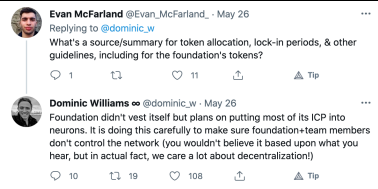
Meanwhile, CoinList and crowd sale participants, typically smaller retail investors, were given either a 12-month vesting schedule or a ~4-year vesting schedule (49, 30-day installments). To explain these lock-ups, Dominic in a tweet stated: “All decisions will be made in the interests of network security. A price collapse would be bad for security...”
It is important to note that not all transfers to exchanges result in a sale, as some investors often hold their digital assets for the security that exchanges like Coinbase offer. But when you already have a treasury wallet there are very few reasons for Dfinity to be transferring tokens to exchanges outside of selling. Either way, this is not industry best practices. ICP did not release a consistent supply schedule, there is no vest on treasury tokens while there is on retail participants, they transferred tokens to numerous exchanges, and they continue to offer no transparency. Worse, the exchanges themselves did nothing to help new buyers of ICP understand these issues, and while they may claim that they simply provide a platform and not an underwritten investment banking service, it is pretty clear that most would have avoided this ICP token had any of this information been known. Similarly, where are the numerous prominent Venture Capital firms who funded Dfinity pushing for change and increased transparency? Both groups are just as much a part of this industry as everyday crypto native users are. The buy-in needs to come from everyone. Not surprisingly, ICP has massively underperformed over the past few months even as other Layer 1 protocols have rallied.
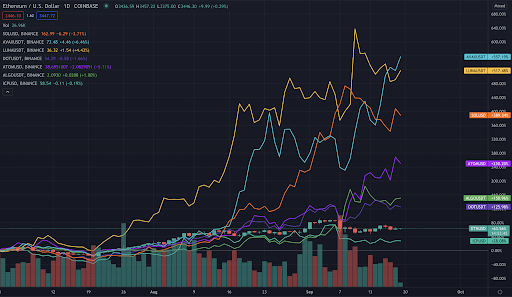
Source: Trading view
Highlighting the Good
The two examples above are not a representation of all digital assets. There are numerous projects (though not nearly enough) that provide amazing transparency reports to investors. These projects are setting the standard for the industry, and point to what we as investors and users should be pushing other projects to be doing, at a bare minimum.
MakerDao
MakerDao, the DAO behind the Dai stablecoin, releases monthly reports on the overall health and growth of the Dai ecosystem. It highlights both the good and the bad and helps equip investors to make informed investment decisions.
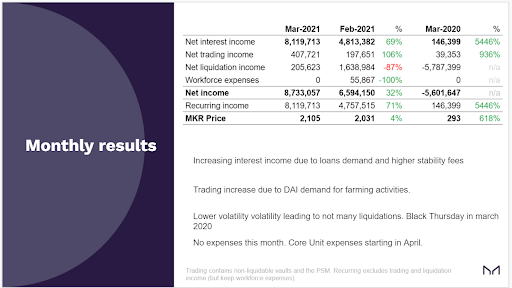
These reports include most items a traditional investor would look for including monthly revenues, expenses, market share, and risks in an easily digestible fashion and none of the fine print that investors have to typically comb through in a 10-K. They also have created a Dune Analytics dashboard (H/T Sébastien Derivaux) for investors to view daily. This is a significantly better system than traditional EDGAR reporting and is made possible by both the transparent nature of digital assets and the ethos of the digital assets space.
MakerDAO isn’t the only project doing this. Aave has weekly reports highlighting revenues by product line, Yearn Finance has quarterly reports, and Nexus Mutual has its revenue dashboard. All of these reports not only help investors make informed decisions, but also lead to projects trading more on fundamentals and growth rather than pure speculation. This in the long-run will lead to more sustainable price appreciation. MKR saw massive price appreciation after they began highlighting Dai’s growth within its dashboard.
Source: Coingecko
Final Thoughts
Even though projects like Maker, AAVE, NXM, and YFI are paving the way on transparency and financial reporting, this has not yet become the industry standard. In fact, one of the leading companies pushing for more transparency, Messari, has largely failed to get companies to update their information via Messari’s transparency dashboard. When asked about it, Messari founder Ryan Selkis told us, “The issue is that there are few sticks to enforcing transparency standards, and paradoxically, the SEC has made things worse because transparency can be viewed as “disclosures by a securities issuer.”
Well that’s disheartening…. Even if companies and projects want to do the right thing, many are not. So how do we change this?
Here are some thoughts on how we think different digital asset participants can make this industry better:
Users, community members, and investors
- Ask projects and founders to highlight tokenomics, vesting schedules, inflation, etc.
- Get on Discords, Telegrams, and Twitter to push projects to release dashboards on the overall health, usage, and revenues of a project.
- If you come across something that seems odd, dig in, research, and call it out publicly. The work ZuwuTV did will help protect retail investors and OpenSea will be a better product because of his work.
Projects/Companies
- Be transparent. That starts with clear outlined token economics. Stop hiding vesting schedules for the treasury, employees, and investors. Inflation only has a negative impact on price when it is not already priced in.
- Highlight your treasury wallets. Encourage investors to watch them and be transparent about the reason for any movements of tokens out of the treasury wallet. Don’t wait for someone like Arca to point out questionable activities.
- Hire a financial analyst to release weekly, monthly, or quarterly reports. Even better, use a grants program to work with community members to complete this. There are thousands of talented developers who would love to help their favorite projects.
- Create a dashboard. Use Dune analytics or create an internal one on your website. Allow investors to check in on your health every single day and help prove why DeFi is a significant improvement over TradFi. If you don’t know what should be included in a dashboard, no worries, investors are here to help. For example, below is a list we sent to the team behind one of our largest investments.
Items for teams to include in a dashboard:
- Monthly Trading Volumes (DEX’s) Total borrow (Lending) Total coverage (Insurance) -- MoM growth, YoY growth
- Revenues -- MoM growth, YoY growth
- Revenues by product -- pie chart, previous month pie chart
- TVL -- MoM growth, YoY growth
- User growth
- User retention
- Valuation -- P/S, P/CF, and the industry average of each metric
- Monthly Expenses
- Treasury Wallet Funds -- Yield earned per month if projects put treasury capital to work
We have a lot of work to do to show the transparent benefits of DeFi over TradFi, but the data and willingness is there. We should all push projects to be more transparent, to publish dashboards and monthly financial reporting.
And if they don’t, we should channel our inner activist and get our hands dirty doing the research to hold projects and each other accountable.
What We’re Reading This Week
Digital Euro Isn’t Guaranteed After Experiment, ECB Advisor Says
And That’s Our Two Satoshis!
Thanks for reading everyone!
Questions or comments, just let us know.
The Arca Portfolio Management Team
Jeff Dorman, CFA - Chief Investment Officer
Katie Talati - Head of Research
Hassan Bassiri, CFA - PM / Analyst
Sasha Fleyshman - PM, Special Situations
Wes Hansen - Head of Trading & Operations
Alex Woodard- Analyst
Mike Geraci- Trader
Kyle Doane- Trader Operations Associate
Nick Hotz, CFA- Analyst
Andrew Stein- VP of Research
To learn more or talk to us about investing in digital assets and cryptocurrency

 What happened this week in the Digital Assets market
What happened this week in the Digital Assets market